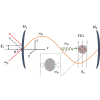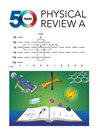空腔 QED 中的磁力学控制 Goos-Hänchen 漂移
IF 2.9
2区 物理与天体物理
Q2 Physics and Astronomy
引用次数: 0
摘要
空腔磁力学系统中涉及磁子、声子和光子之间相互作用的现象,由于其在微波频率范围内的潜在应用,最近引起了相当大的关注。光子-磁子-声子三方相互作用的探针场响应就是其中一种重要效应。在本文中,我们研究了空腔磁力学系统中反射探针场的 Goos-Hänchen 偏移(GHS)。我们将一个钇铁石榴石(YIG)球体置于一个微波腔内。微波控制场直接驱动 YIG 球中的磁子模式,而空腔则通过微弱的探测场驱动。我们的研究结果表明,通过控制场的磁子-声子耦合,可以对 GHS 进行相干控制。例如,通过调整磁子-声子耦合,可以将 GHS 从正调谐到负。同样,有效腔体失谐也是 GHS 的另一个重要控制参数。此外,我们还观察到,当共振时镁-声子耦合较弱以及镁-光子耦合约等于微波光子损耗时,GHS 会增强。我们的发现可能对微波开关和传感相关应用具有潜在意义。本文章由计算机程序翻译,如有差异,请以英文原文为准。

Magnomechanically controlled Goos-Hänchen shift in cavity QED
Phenomena involving interactions among magnons, phonons, and photons in cavity magnomechanical systems have attracted considerable attention recently, owing to their potential applications in the microwave frequency range. One such important effect is the response of a probe field to such a tripartite interaction between photon-magnon-phonon. In this paper we study the Goos-Hänchen shift (GHS) of a reflected probe field in a cavity magnomechanical system. We consider a yttrium iron garnet (YIG) sphere positioned within a microwave cavity. A microwave control field directly drives the magnon mode in the YIG sphere, whereas the cavity is driven via a weak probe field. Our results show that the GHS can be coherently controlled through magnon-phonon coupling via the control field. For instance, the GHS can be tuned from positive to negative by tuning the magnon-phonon coupling. Similarly, the effective cavity detuning is another important controlling parameter for the GHS. Furthermore, we observe that the enhancement of the GHS occurs when magnon-phonon coupling is weak at resonance and when the magnon-photon coupling is approximately equal to the loss of microwave photons. Our findings may have potential significance in applications related to microwave switching and sensing.
求助全文
通过发布文献求助,成功后即可免费获取论文全文。
去求助
来源期刊

Physical Review A
物理-光学
CiteScore
5.40
自引率
24.10%
发文量
0
审稿时长
2.2 months
期刊介绍:
Physical Review A (PRA) publishes important developments in the rapidly evolving areas of atomic, molecular, and optical (AMO) physics, quantum information, and related fundamental concepts.
PRA covers atomic, molecular, and optical physics, foundations of quantum mechanics, and quantum information, including:
-Fundamental concepts
-Quantum information
-Atomic and molecular structure and dynamics; high-precision measurement
-Atomic and molecular collisions and interactions
-Atomic and molecular processes in external fields, including interactions with strong fields and short pulses
-Matter waves and collective properties of cold atoms and molecules
-Quantum optics, physics of lasers, nonlinear optics, and classical optics
 求助内容:
求助内容: 应助结果提醒方式:
应助结果提醒方式:


